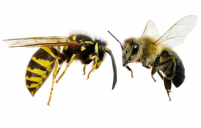 Photo by http://www.about-bees.com/ Photo by http://www.about-bees.com/ This is the time of the year that our ever peaceful Honey Bees take a bad wrap for their not so friendly cousins the Yellowjacket Wasp. There are some very clear differences to look for. Yellowjacket Wasps are skinny and shiny (no noticeable hairs). Eat other insects (soft bodied caterpillars, and spiders) and are beneficial predators. Wasps are carnivores and may be attracted to meat at your picnic. They also are attracted to sweet soft drinks. Honey Bees are fatter, and appear fuzzy or hairy. Bees eat pollen and nectar from flowers and are beneficial pollinators. Bees do not eat meat and are not attracted to your picnic. They generally are not attracted to soft drinks Yellowjackets are one type of wasp. They live in a social colony and the nest looks like a greyish paper carton. Yellowjackets usually nest underground in an abandoned rodent burrow and are readily seen flying in and out, especially if you run your lawn mower over the opening of the nest. If they are living in the wall of a house, you will not see the paper nest, but you will see them flying in and out. Yellowjackets have an annual colony, meaning the entire colony of wasps will die off after two hard frosts. Colony populations will range from a few dozen to a few hundred individuals. Only new queens survive the winter by hibernating underground. The queens will establish new nests in spring and will not reuse the old paper nest. Yellowjackets have a smooth stinger, which means they can sting multiple times, and do not die after stinging. There is no stinger left behind at the stinging site. Yellowjackets do not produce or store honey Honey bees are one type of bee. They are orange-yellow, gray or brown and black banded, and fuzzy. They are also social and the nest is constructed of beeswax. Honey bees nest in a beehive, a cavity of a tree, or sometimes in the wall of a house, where they can be seen flying in and out. They do not nest in a hole in the ground. Honey bees form perennial colonies, meaning the entire colony of bees can survive the winter, clustering in the nest and producing heat by consuming stored honey. Honey bee colonies have much larger populations, often approaching 30,000+ individuals at the height of the summer season. Honey bees can sting only once and die after stinging. The stinger and poison sac are often seen left in the skin at the sting site. Honey bees are the only type of bee that collects large amounts of nectar and pollen from flowers to store in the nest, to use as food during the colder times of the year. So do Honey bees or Yellowjackets in your home? If you have yellowjackets, rest assured they will be gone after two hard frosts. If they are not bothering you, ask yourself if you can live with them and appreciate them as beneficial predators. If you cannot live with them, you may need to exterminate them. If it is late summer or fall, keep in mind the colony has been growing there all season, and if they have not bothered you, they likely won’t start. If you have a honey bee colony nesting in the wall of your house, ask yourself if you can live with them and appreciate that they are beneficial pollinators. If you cannot live with them, you will need to try to locate a willing beekeeper and contractor for removal options. In most cases, there is no easy or inexpensive solution to removing a honey bee colony from a house, as de-construction is necessary to open up the wall cavity to remove the bees and wax combs. If it has been determined that the honey bees must be removed, the best time to do so is often in late winter or early spring. The reason for this is that by that time of the year, the bee population is often at its lowest point, meaning fewer bees to deal with. Also, much of the stored honey will have been consumed by the bees over winter, so there will be less honey in the combs to deal with. Often the bee colony will die over the winter, usually due to insufficient population to maintain adequate temperature for the bees to survive; insufficient reserves of honey, so the colony starves to death over winter; or the colony succumbs to parasitic mites. In all of these cases, it is much easier to deal with the remaining bee less combs, as the bees will have perished, making removal much easier (no stinging insects to protect the nest!). It is not a good idea to just plug the entrance hole of an active honey bee colony in this type of situation. Once the bees can’t get out and die in the wall, there will no longer be temperature regulation of the nest cavity. This in time may result in the melting of the honey comb, and the leakage of honey down into the wall, which will attract other insects and possibly rodents. There will also be developing brood or baby bees in the comb which will also die, leading to bad odors and attraction of other scavenger insects and pests. Some tips to keep Yellowjackets away from you house or picnic. Don't leave rotten fruit or meat outside. Keep garbage can lids on and keep cans clean inside and out, and bag garbage. Wipe down picnic tables after eating on them so Yellowjackets are not attracted to them.
8 Comments
|
ContributorsWe love to feature blogs from all of the members of our team, including core staff, interns, volunteers, and others. We hope you enjoy the stories and find the information useful! Archives
January 2023
Categories |
AddressLaSalle Square
3701 Prast Blvd. South Bend, IN. 46628 |
Hours
Garden: always Welcome Center Mon-Sun: 9am-7:30pm |
Telephone574-222-2266
After Hours: 574-315-4361 |
Unity Gardens
PO Box 10022 South Bend, IN. 46680 |

 RSS Feed
RSS Feed